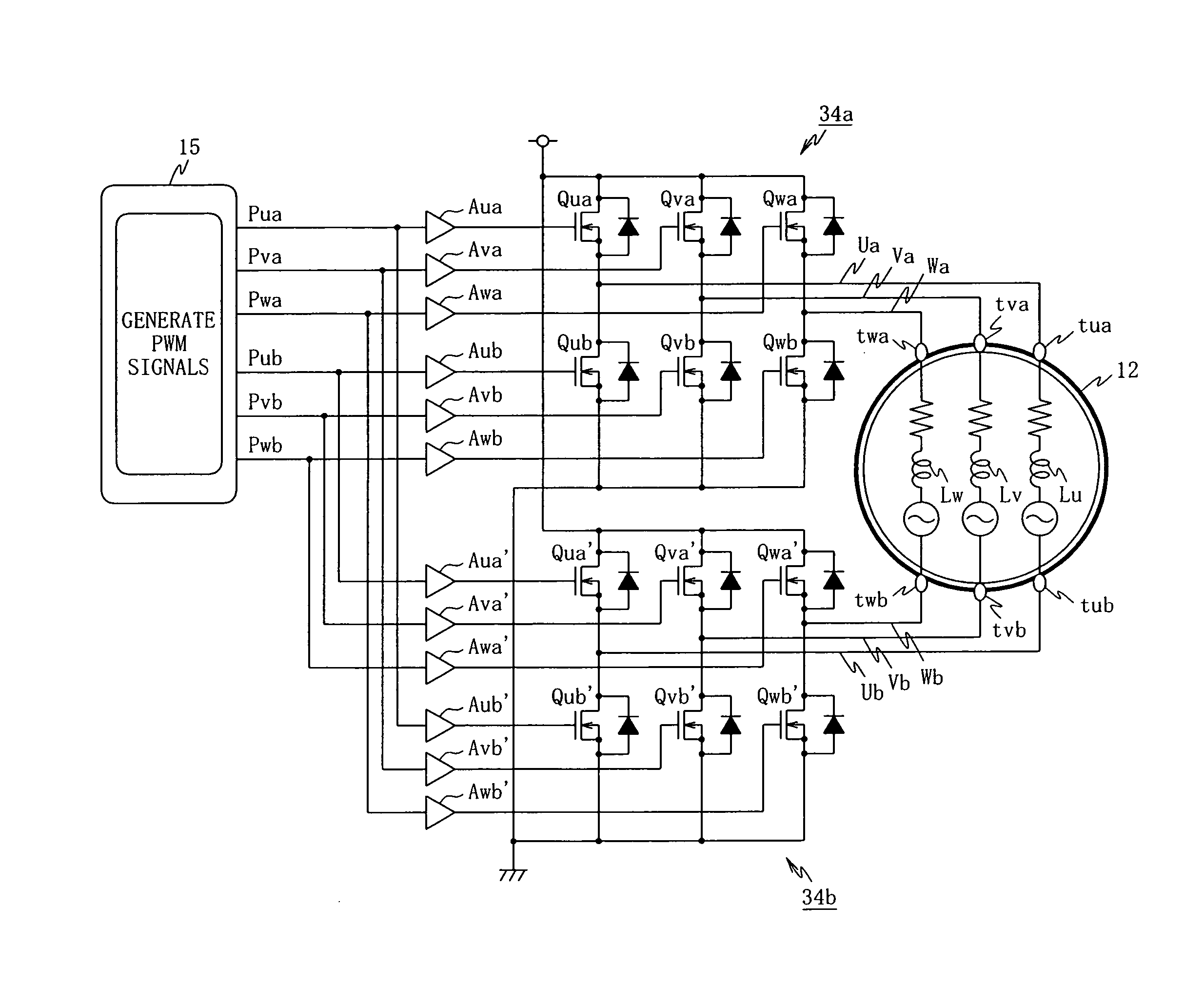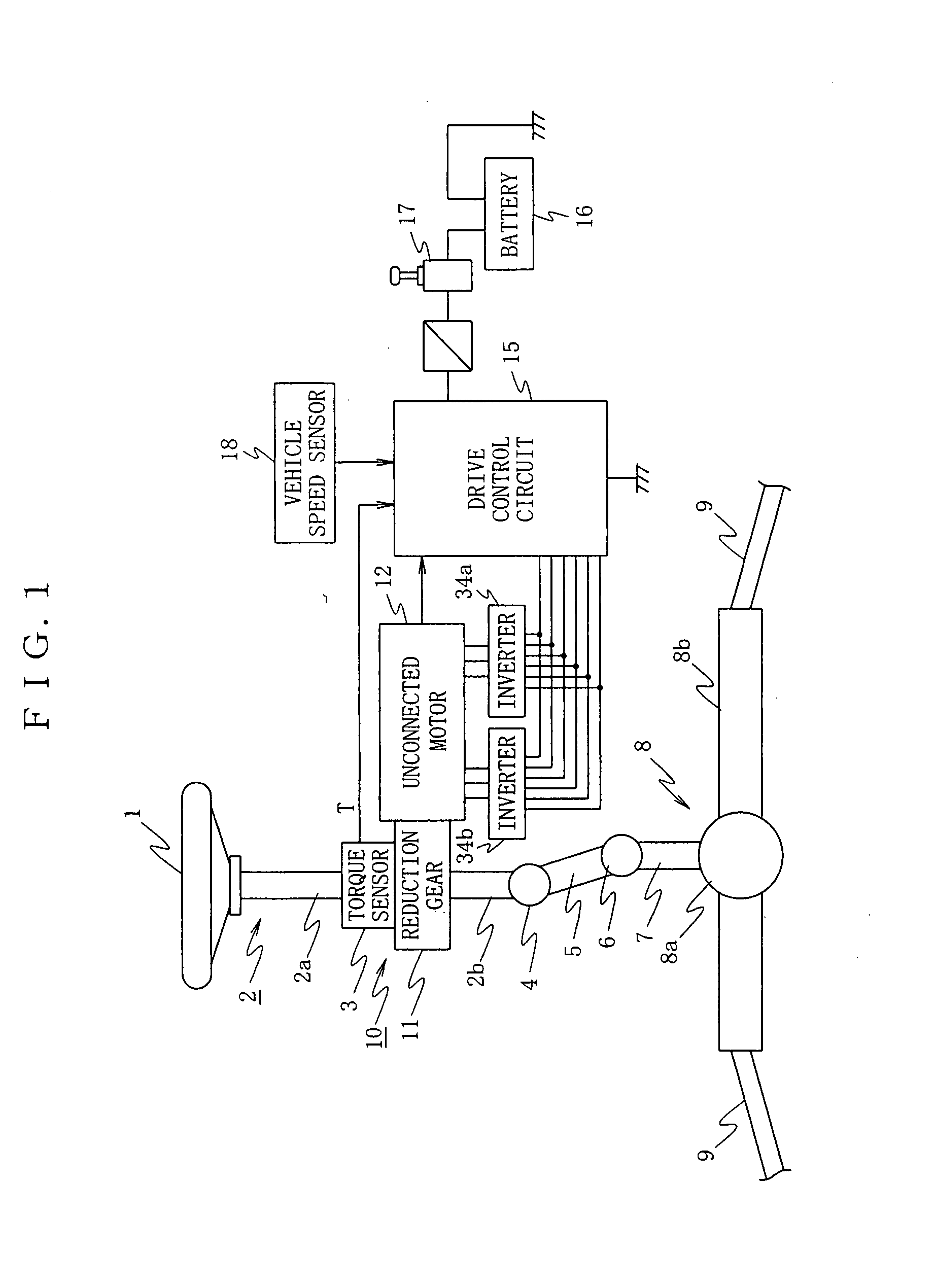Unconnected Motor, Drive Control Device Thereof, And Electric Power Steering Device Using Drive Control Device Of Unconnected Motor
a technology of unconnected motors and control devices, which is applied in the direction of motor/generator/converter stoppers, dynamo-electric gear control, and dynamo-electric converter control. it can solve the problems of limited further increase of output and inability of three-phase motors to apply a third harmonic wave to excitation coils
- Summary
- Abstract
- Description
- Claims
- Application Information
AI Technical Summary
Benefits of technology
Problems solved by technology
Method used
Image
Examples
first embodiment
[0223] Next, operations of the above-described first embodiment will be explained.
[0224] Assume that a vehicle is presently at rest, the unconnected motor 12 is also suspended, the steering wheel 1 has not been steered and the steering torque T sensed by the steering torque sensor 3 takes a value of “0”. In this state, since the steering torque T is “0”, the target assist steering torque Tt calculated by the target assist steering torque calculation section 43 also takes a value of zero, which is the value supplied to the multipliers 44u to 44w.
[0225] At this point, if it is assumed that a phase of the rotor 20 sensed by the phase sensing section 35 of the unconnected motor 12 and supplied to the electrical angle conversion section 41 results in an electrical angle θ of 0 degrees, a phase current target value Iut outputted from the phase current target value calculation section 42u will take a value of “0”, a phase current target value Ivt outputted from the phase current target va...
second embodiment
[0252] the present invention will now be described with reference to FIGS. 17 and 18.
[0253] The second embodiment is arranged so that the drive control circuit 15 is controlled through application of pseudo vector control.
[0254] More specifically, as shown in FIG. 17, the second embodiment is arranged so that the drive control circuit 15 determines current command values of vector control d and q components at a vector control phase command value calculation circuit 70 using the excellent properties of vector control, subsequently converts the current command values into each phase current command value corresponding to each excitation coil Lu to Lw, and closes everything using phase control instead of d and q control at a current control section 80. Therefore, since the theory of vector control is utilized at the stage of calculating current command values, the present control method will be referred to as pseudo vector control (hereinafter abbreviated as “PVC control”).
[0255] Th...
third embodiment
[0276] the present invention will now be described with reference to FIG. 19.
[0277] The third embodiment has been arranged so that the configuration of the drive control circuit 15 is now entirely performed via vector control.
[0278] More specifically, as shown in FIG. 19, with the exception of the omission of the two-phase to three-phase transformation section 74 of the vector control phase current command value calculation section 70 of the aforementioned second embodiment, as well as the provision of a three-phase to two-phase transformation section 90 which transforms inputted motor currents Iu, Iv and Iw sensed by current sensors 51u, 51v and 51w, to q-axis and d-axis sensed currents Idq and Idd, and changes made to the current control section 80 as described below, the third embodiment has the same configuration as that shown in FIG. 17. Thus, portions corresponding to those shown in FIG. 17 are assigned like reference characters and detailed descriptions thereof will be omitt...
PUM
 Login to View More
Login to View More Abstract
Description
Claims
Application Information
 Login to View More
Login to View More - R&D
- Intellectual Property
- Life Sciences
- Materials
- Tech Scout
- Unparalleled Data Quality
- Higher Quality Content
- 60% Fewer Hallucinations
Browse by: Latest US Patents, China's latest patents, Technical Efficacy Thesaurus, Application Domain, Technology Topic, Popular Technical Reports.
© 2025 PatSnap. All rights reserved.Legal|Privacy policy|Modern Slavery Act Transparency Statement|Sitemap|About US| Contact US: help@patsnap.com



